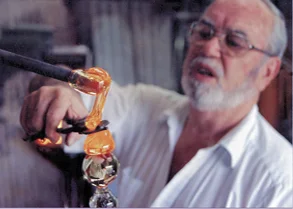In the early 1950s, Hamon Glass Company made several thousand communion glasses a day. The handsome hand-blown wonders were high-quality vessels that would receive wine or grape juice for the Christian sacrament of communion in many churches across America. As a kid, I spent a fair amount of time hanging around the family glass factory and watching in amazement, as the workers blew glass. I thought the tiny chalices were simply fascinating. Just one communion glass was an impressive sight, but a table piled-high with them was a treasure trove. Our communion ware was wrapped in white tissue paper and placed in white cardboard boxes, before being shipped to churches all across America.
Not only were the glasses small, but they were shiny and translucent, and no less intriguing than precious gems. I spent hours watching my father and the other glassblowers making the crystal chalices, and never seemed to get bored. After all, I was watching a well-choreographed dance, as two men working together produced the dimunitive treasures that meant so much to my grandfather, the founder of Hamon Glass Company. Sometimes there were several two-man teams working at the same time, which made it even more interesting for us bystanders.
Although my grandfather’s business eventually made decorative glass, I think the communion glasses were his favorite product. Religion was important to him. There was a need and he wanted to fill it. As a minister with his own church, he enjoyed supplying churches of different denominations with handmade crystal chalices. I recall how hefty and solid the glasses felt in the hand, and how beautiful the crystal was when held up to the light. And being hand-blown, each glass had its own character.
Hamon Glass gave my uncle, Robert Hamon, his start in glass. Eventually, he would take the company over, as my grandparents transitioned into retirement, and turn the business into a studio where he would focus on creating glass art. He would make bigger and greater things, although, in my mind, nothing serves as a better reminder of the company’s humble, but noble beginnings than the simple, yet elegant communion glass.
— Richard Hamon II
